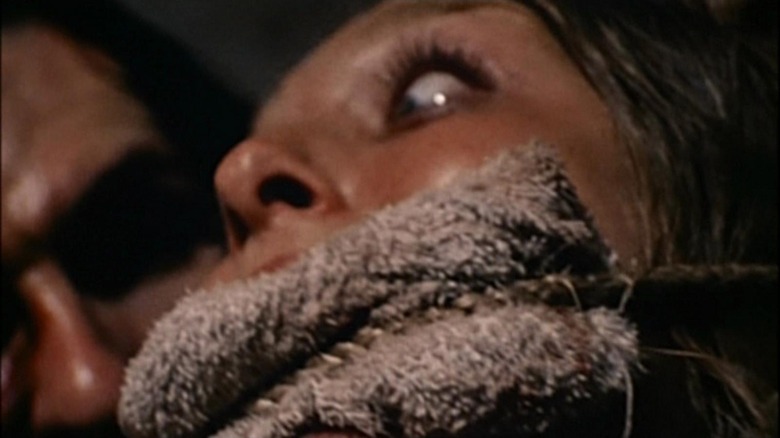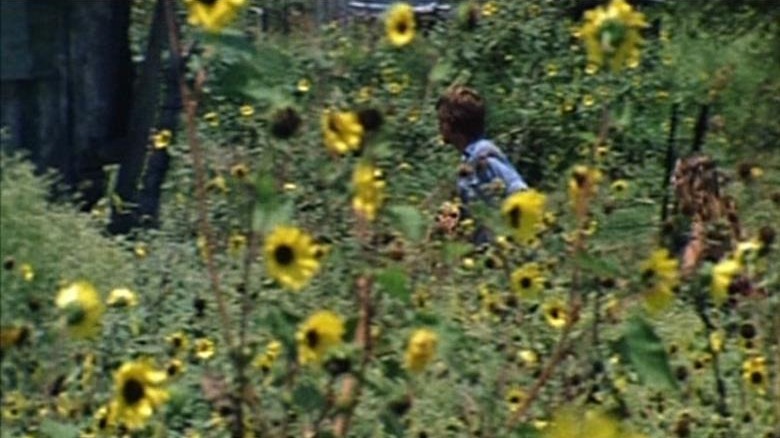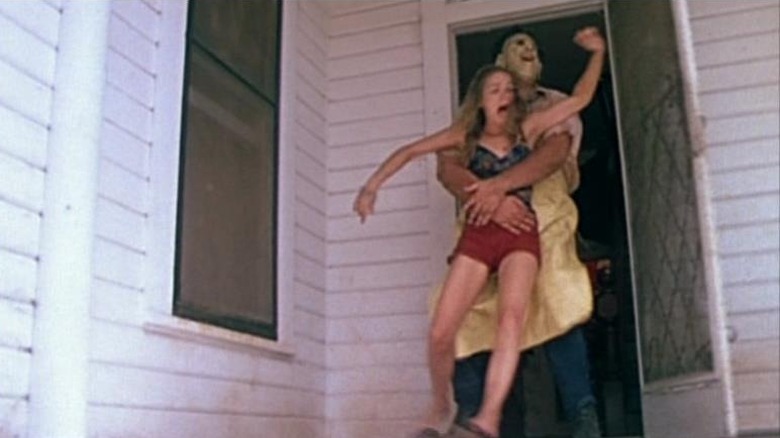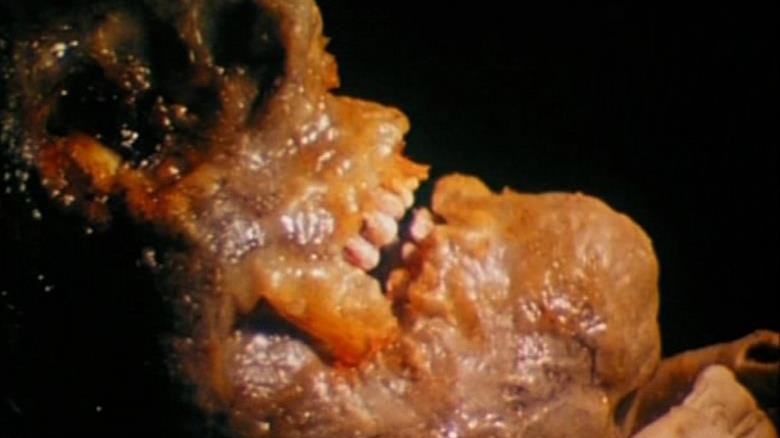How Tobe Hooper Crafted The Terrifying Soundscape Of The Texas Chain Saw Massacre
"The Texas Chain Saw Massacre" is a shocking movie. Women are impaled on meat hooks. Men are chopped to pieces. Furniture crafted from animal bones and human limbs lurk in the corners. Yet there is surprisingly little gore to be found. The deaths are mostly bloodless. Flesh wounds appear on screen in only a handful of scenes. When Leatherface plunges his chain saw into the wheelchair-bound Franklin, the audience is given a mere handful of viscera rather than the volcano of blood they might expect. "The Texas Chain Saw Massacre" was marketed as being based on a true story. But it uses suggestion just as effectively as it does verisimilitude.
Why avoid gore? Realistic blood and guts cost money, which director Tobe Hooper and his crew didn't have. It was to their best advantage to scare their audience via creative shortcuts. But Hooper had more on his mind than saving money. He wanted to make a film that would infect the dreams of its audience. A film that would make them consider how it felt to readjust your weight while hanging on a meat hook, or how it felt to be tied to an armchair made of literal human arms. Hooper and his crew used every tool in the box to achieve their goal. From the beginning, their secret weapon was sound.
I wanted the sound to be aggressive
"The idea behind 'The Texas Chain Saw Massacre,'" Hooper said in an interview with Flashback Files, "was that the movie would enter your mind the way music does." From the very beginning, Hooper wanted his film to be something that his audience felt, not just something they saw. The story of "Texas Chain Saw Massacre" is outrageous enough as a sequence of events. Its production was hellish, riddled with smelly animal bones, vomiting crew members and injuries on set. But the film's greatest strength is how it conveys that deep-rooted sensory filth, spiked with the nihilism of the 1970s, directly to its viewers. The sound was a crucial part of that assault, designed to put the viewer on edge. "I wanted the sound to be aggressive," Hooper said, "so that you'd respond."
"The Texas Chain Saw Massacre" sound team was mostly sourced from the University of Texas at Austin. Its film program was threadbare at the time. Even so, there were some real stand-outs working on the project. Hooper specifically shouts out Buzz Knudson in the Flashback Files interview. Knudson had previously won Academy Awards for "Cabaret" and "The Exorcist." He would play the role of dubbing mixer on the set of "Texas Chain Saw Massacre" alongside Jay Harding, creating the final audio mix after Hooper and his team had cut the film together. Due to problems behind the scenes, Knudson had to do the job twice. That the film sounds as good as it does, despite (or even because) of its rough edges, is a small miracle.
Every part of the body
Another major player on the sound team was Wayne Bell, who composed the soundtrack alongside Hooper, operated the boom and handled post-production sound. In an interview with Designing Sound, Bell stresses the importance of planning in a low budget production like 'Texas Chain Saw Massacre." "Everything you hear as far as dialogue was recorded on set," he says. "Between the various takes and wild track [sounds recorded separately from the action on set that are later synced to the movie,] that is what you hear in the final mix." One of the few exceptions to this rule were the radio voices used in the film, which were recorded elsewhere at a "classic hippie low-budget studio with egg crates on the wall with cloth in front of it to deaden the room."
Like the butchers of "The Texas Chainsaw Massacre," the film's sound team had to use every part of "the body" available to them. The chainsaw sounds were all recorded on set. Wayne Bell's father contributed the pig squeals Kirk hears before he is killed by Leatherface. The final result is eccentric, but that just adds to the film's charisma. As Bell said in the interview quoted above, "the imperfection became a part of what the film is and why people love it." Even the soundtrack is off-kilter, featuring a lap steel guitar alongside children's percussion instruments like xylophones and cymbals. It is as influential as John Carpenter's soundtrack to "Halloween," despite its lack of a memorable theme tune.
The sound of the unknown
There's a sense of mystery to the sound mix of "The Texas Chain Saw Massacre" that remains even today. The beginning of the film features a distinctive sound meant to emulate a camera shutter. To this day, Wayne Bell still refuses to explain exactly what the film's crew did to create that sound. To do so would be to give shape to the horror, and render the inexplicable explainable. All audiences needed to be scared, Bell believed, was the bare minimum. "You can introduce an idea," he said, "and the mind of the listener fills it in."
The film critic Scout Tafoya backs up Bell's assertion in his book "Cinephagy," describing "The Texas Chain Saw Massacre" as "a grimy mix of realism and expressionism." When Leatherface brings the hammer down on Kirk's head, the resulting sound seems revoltingly true to life. Afterwards, Leatherface slams a big metal door shut, ending the scene with what Tafoya refers to as "a low rumbling organ." It sounds nothing like a closed door, but taps into the same sense of shock and unease. The constant tension between the tangible details and many strange flourishes of "The Texas Chain Saw Massacre" remain central to its power. Even today, it infects the ear and the mind, just as Hooper and his team wanted.



